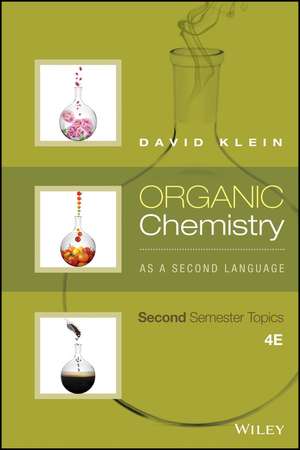Organic Chemistry as a Second Language: Second Semester Topics
Autor David R. Kleinen Limba Engleză Paperback – 18 apr 2016
Preț: 878.13 lei
Preț vechi: 1155.02 lei
-24% Nou
Puncte Express: 1317
Preț estimativ în valută:
168.04€ • 179.68$ • 140.10£
168.04€ • 179.68$ • 140.10£
Carte indisponibilă temporar
Doresc să fiu notificat când acest titlu va fi disponibil:
Se trimite...
Preluare comenzi: 021 569.72.76
Specificații
ISBN-13: 9781119110651
ISBN-10: 1119110653
Pagini: 400
Dimensiuni: 152 x 231 x 13 mm
Greutate: 0.45 kg
Ediția:4th Edition
Editura: Wiley
Locul publicării:Hoboken, United States
ISBN-10: 1119110653
Pagini: 400
Dimensiuni: 152 x 231 x 13 mm
Greutate: 0.45 kg
Ediția:4th Edition
Editura: Wiley
Locul publicării:Hoboken, United States
Cuprins
Chapter 1 Aromaticity
1.1 Introduction to Aromatic Compounds
1.2 Nomenclature of Aromatic Compounds
1.3 Criteria for Aromaticity
1.4 Lone Pairs
Chapter 2 IR Spectroscopy
2.1 Vibrational Excitation
2.2 IR Spectra
2.3 Wavenumber
2.4 Signal Intensity
2.5 Signal Shape
2.6 Analyzing an IR Spectrum
Chapter 3 NMR Spectroscopy
3.1 Chemical Equivalence
3.2 Chemical Shift (Benchmark Values)
3.3 Integration
3.4 Multiplicity
3.5 Pattern Recognition
3.6 Complex Splitting
3.7 No Splitting
3.8 Hydrogen Deficiency Index (Degrees of Unsaturation)
3.9 Analyzing a Proton NMR Spectrum
3.10 13C NMR Spectroscopy
Chapter 4 Electrophilic Aromatic Substitution
4.1 Halogenation and the Role of Lewis Acids
4.2 Nitration
4.3 Friedel–Crafts Alkylation and Acylation
4.4 Sulfonation
4.5 Activation and Deactivation
4.6 Directing Effects
4.7 Identifying Activators and Deactivators
4.8 Predicting and Exploiting Steric Effects
4.9 Synthesis Strategies
Chapter 5 Nucleophilic Aromatic Substitution
5.1 Criteria for Nucleophilic Aromatic Substitution
5.2 SNAr Mechanism
5.3 Elimination–Addition
5.4 Mechanism Strategies
Chapter 6 Ketones and Aldehydes
6.1 Preparation of Ketones and Aldehydes
6.2 Stability and Reactivity of C¨O Bonds
6.3 H–Nucleophiles
6.4 O–Nucleophiles
6.5 S–Nucleophiles
6.6 N–Nucleophiles
6.7 C–Nucleophiles
6.8 Some Important Exceptions to the Rule
6.9 How to Approach Synthesis Problems
Chapter 7 Carboxylic Acid Derivatives
7.1 Reactivity of Carboxylic Acid Derivatives
7.2 General Rules
7.3 Acid Halides
7.4 Acid Anhydrides
7.5 Esters
7.6 Amides and Nitriles
7.7 Synthesis Problems
Chapter 8 Enols and Enolates
8.1 Alpha Protons
8.2 Keto–Enol Tautomerism
8.3 Reactions Involving Enols
8.4 Making Enolates
8.5 Haloform Reaction
8.6 Alkylation of Enolates
8.7 Aldol Reactions
8.8 Claisen Condensation
8.9 Decarboxylation
8.10 Michael Reactions
Chapter 9 Amines
9.1 Nucleophilicity and Basicity of Amines
9.2 Preparation of Amines through SN2 Reactions
9.3 Preparation of Amines through Reductive Amination
9.4 Acylation of Amines
9.5 Reactions of Amines with Nitrous Acid
9.6 Aromatic Diazonium Salts
Chapter 10 Diels–Alder Reactions
10.1 Introduction and Mechanism
10.2 The Dienophile
10.3 The Diene
10.4 Other Pericyclic Reactions
Answer Key
Index
1.1 Introduction to Aromatic Compounds
1.2 Nomenclature of Aromatic Compounds
1.3 Criteria for Aromaticity
1.4 Lone Pairs
Chapter 2 IR Spectroscopy
2.1 Vibrational Excitation
2.2 IR Spectra
2.3 Wavenumber
2.4 Signal Intensity
2.5 Signal Shape
2.6 Analyzing an IR Spectrum
Chapter 3 NMR Spectroscopy
3.1 Chemical Equivalence
3.2 Chemical Shift (Benchmark Values)
3.3 Integration
3.4 Multiplicity
3.5 Pattern Recognition
3.6 Complex Splitting
3.7 No Splitting
3.8 Hydrogen Deficiency Index (Degrees of Unsaturation)
3.9 Analyzing a Proton NMR Spectrum
3.10 13C NMR Spectroscopy
Chapter 4 Electrophilic Aromatic Substitution
4.1 Halogenation and the Role of Lewis Acids
4.2 Nitration
4.3 Friedel–Crafts Alkylation and Acylation
4.4 Sulfonation
4.5 Activation and Deactivation
4.6 Directing Effects
4.7 Identifying Activators and Deactivators
4.8 Predicting and Exploiting Steric Effects
4.9 Synthesis Strategies
Chapter 5 Nucleophilic Aromatic Substitution
5.1 Criteria for Nucleophilic Aromatic Substitution
5.2 SNAr Mechanism
5.3 Elimination–Addition
5.4 Mechanism Strategies
Chapter 6 Ketones and Aldehydes
6.1 Preparation of Ketones and Aldehydes
6.2 Stability and Reactivity of C¨O Bonds
6.3 H–Nucleophiles
6.4 O–Nucleophiles
6.5 S–Nucleophiles
6.6 N–Nucleophiles
6.7 C–Nucleophiles
6.8 Some Important Exceptions to the Rule
6.9 How to Approach Synthesis Problems
Chapter 7 Carboxylic Acid Derivatives
7.1 Reactivity of Carboxylic Acid Derivatives
7.2 General Rules
7.3 Acid Halides
7.4 Acid Anhydrides
7.5 Esters
7.6 Amides and Nitriles
7.7 Synthesis Problems
Chapter 8 Enols and Enolates
8.1 Alpha Protons
8.2 Keto–Enol Tautomerism
8.3 Reactions Involving Enols
8.4 Making Enolates
8.5 Haloform Reaction
8.6 Alkylation of Enolates
8.7 Aldol Reactions
8.8 Claisen Condensation
8.9 Decarboxylation
8.10 Michael Reactions
Chapter 9 Amines
9.1 Nucleophilicity and Basicity of Amines
9.2 Preparation of Amines through SN2 Reactions
9.3 Preparation of Amines through Reductive Amination
9.4 Acylation of Amines
9.5 Reactions of Amines with Nitrous Acid
9.6 Aromatic Diazonium Salts
Chapter 10 Diels–Alder Reactions
10.1 Introduction and Mechanism
10.2 The Dienophile
10.3 The Diene
10.4 Other Pericyclic Reactions
Answer Key
Index
Descriere
Readers continue to turn to Klein′s Organic Chemistry As a Second Language: Second Semester Topics, 4th Edition because it enables them to better understand fundamental principles, solve problems, and focus on what they need to know to succeed.
